|
|
|
Sort Order |
|
|
|
Items / Page
|
|
|
|
|
|
|
| Srl | Item |
| 1 |
ID:
145695
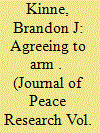

|
|
|
|
|
| Summary/Abstract |
This article assesses the impact of a new form of defense cooperation – formal weapons cooperation agreements, or WCAs – on the global arms trade. WCAs are bilateral framework agreements that establish comprehensive guidelines on the development, production, and exchange of conventional arms. Substantively, WCAs regulate such core areas as procurement and contracting, defense-based research and development, and defense industrial cooperation. These agreements have proliferated dramatically since the mid-1990s. They now number nearly 700, with 30–40 new WCAs signed each year. Newly collected data are used to analyze the effect of WCAs on import and export of conventional weapons. To control for interdependencies in the formation of WCAs, and to account for the mutually endogenous relationship between WCAs and weapons flows, WCAs are modeled as an interdependent network that coevolves with the individual-level arms trade activity of states. The analysis shows that, over the 1995–2010 period, WCAs have significantly increased weapons flows.
|
|
|
|
|
|
|
|
|
|
|
|
|
|
|
|
| 2 |
ID:
145702
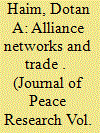

|
|
|
|
|
| Summary/Abstract |
How does the network of international political alliances influence trade flows? Previous work suggests that alliances matter in predicting trade outcomes because governments align trade policies with national security interests and firms take political relations between states into account when assessing risk. However, work to date investigates only the relationship between direct political alliances and trade, which ignores the complexity of international alliance structures. In this article, I argue that states and firms not only consider direct political relationships when shaping international trade, but also focus crucially on indirect alliance relationships. I find that higher levels of trade result when states have more shared alliances and when they are in the same alliance community. Once these indirect relationships are accounted for, the apparent association of dyadic alliances with trade is drastically reduced. Joint membership in an alliance community predicts an increase in trade that is more than twice the increase associated with a dyadic alliance. This effect is magnified when considering highly ‘central’ states in the alliance network. States trade significantly more with central states in their own alliance community and less with central states in other communities.
|
|
|
|
|
|
|
|
|
|
|
|
|
|
|
|
| 3 |
ID:
128975
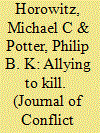

|
|
|
|
|
| Publication |
2014.
|
| Summary/Abstract |
Terrorist organizations do not operate in isolation. Instead, they forge alliances with one another, which generate a tight network of intergroup relationships. We argue that these relationships serve to increase group capacity, manifesting itself in the ability of a group to conduct deadly attacks. However, groups are notably judicious when they forge these cooperative ties, preferring to link to the strongest groups to which they have access. The result of this process of preferential attachment is a core/periphery structure in the broader network of alliances. Moreover, groups with ties to organizations at the core of the broader universe of relationships reap more rewards than those with large numbers of less meaningful alliances. Terrorism research and counterterrorism policy should assess terrorist organizations in the broader context of their interrelationships and depth of alliances rather than in isolation.
|
|
|
|
|
|
|
|
|
|
|
|
|
|
|
|
| 4 |
ID:
159248
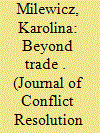

|
|
|
|
|
| Summary/Abstract |
Increased complexity and density of transnational problems create unprecedented challenges and opportunities for contemporary international governance. “Issue linkage” is one institutional arrangement through which states address these changing circumstances. In this article, we examine the widening scope of the nontrade agenda in preferential trade agreements (PTAs). Nontrade issues (NTIs) such as human rights, democracy, environment, corruption, and labor standards are increasingly linked to PTAs. This issue linkage has important implications for understanding changing patterns of international trade, including the shift to PTAs and the rise of NTIs. We show that (1) states’ choices to commit to bilateral or plurilateral versions of traditional PTAs and to PTAs with NTIs are highly interdependent, (2) states increasingly incorporate NTIs into PTAs, as the associated costs of policy change are lowered through earlier agreements, and (3) network pressures favor the increasing adoption of bilateral and especially plurilateral NTIs over time. Using an original data set on NTIs covering 522 PTAs and spanning the period 1951 to 2009, we evaluate states’ motives behind the widening nontrade agenda of trade agreements using longitudinal network modeling. We employ multiplex coevolution stochastic actor-oriented network models in a novel design to account for interdependencies within and across states’ decisions. Following a descriptive mapping of major NTIs, we evaluate our theoretical arguments. Testing against the alternative explanations of power and commitment, we find that endogenous cost considerations are the most significant factor explaining the inclusion of NTIs into PTAs.
|
|
|
|
|
|
|
|
|
|
|
|
|
|
|
|
| 5 |
ID:
155382
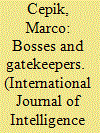

|
|
|
|
|
| Summary/Abstract |
Comparing intelligence services meets three recurrent challenges. Getting to know what is unique about specific organizations in different countries is always a powerful research driver. The general preference, then, is for insightful descriptive case studies. Second, the intricacy of the international security context and its dual level dynamics tend to drive off comparative studies. Third, the legal and practical impediments for researching organizations with secrecy and deception as constitutive features make evidence-based comparative assessments difficult. Indeed, intelligence might well be an odd subject for comparatists. Nonetheless, intelligence systems in different countries do undertake a similar set of missions and functions. They vary in terms of effectiveness and legitimacy according to the institutional history, political culture, and relative power and wealth of each country.
|
|
|
|
|
|
|
|
|
|
|
|
|
|
|
|
| 6 |
ID:
176695


|
|
|
|
|
| Summary/Abstract |
There are overwhelming proofs that world-wide carbon emission profiles have been substantially shaped by carbon leakage through international trade. However, it has been unclear how structure and functions of the global carbon transfers evolve in terms of a complex network. Therefore, this study applies a series of network tools to depict the evolution features of the global carbon flow network from 1995 to 2011 as supported by a systems multi-regional input-output analysis. At global level, the network density increases essentially, indicating the widely expanding carbon leakages among economies. The increasingly distinct scale-free distribution for cumulative degree/weighted degree implies the network's intensified heterogeneity structure. At regional level, a new tripartite cluster structure has been identified by the three gradually stabilized communities centered on USA, China and Europe. At national level, the evolution for all economies' roles, especially two prominent groups (i.e. G8 and BRICS), is enunciated by coreness in context of the core-periphery structure, highlighting the significance of monitoring core economies' carbon emission flows. The results urge the need to shift from local carbon mitigation in silos to global collective and inclusive governance. Regional cluster structure's identification highlights the urgency for multinational cooperation on emission mitigation within the three newly formulated communities.
|
|
|
|
|
|
|
|
|
|
|
|
|
|
|
|
| 7 |
ID:
137234
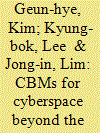

|
|
|
|
|
| Summary/Abstract |
This paper aims to analyze confidence-building measures (CBMs) for cyberspace taking place in Northeast Asia. Accordingly, it explores features of cyber security in the Northeast Asian region and concepts of CBMs for cyberspace. Then, it studies networks of CBMs for cyberspace that took place on the government level in the region from 2009 through the first half of 2014 by using the network analysis method, which is useful for studying current social relations. This study analyzes the structure of CBMs networks used in the region for the past six years and the actors. Conclusions of this study are as follows: First, CBMs for cyberspace in Northeast Asia are focused on the United States. Second, the CBMs in the region have similar features to those of traditional security cooperation. Thirdly, they are strongly based on realism. From the perspective of networks, this study is meaningful in that it used a macro approach to analyze CBMs, which was difficult to perform by using conventional methods.
|
|
|
|
|
|
|
|
|
|
|
|
|
|
|
|
| 8 |
ID:
143299
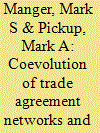

|
|
|
|
|
| Summary/Abstract |
The proliferation of preferential trade agreements (PTAs) and the wave of democratization are among the most significant developments in international relations during the past three decades. The correlation between these is well noted. The causal link between these phenomena, however, remains unclear. On one hand, democracies have been found to be more likely to join PTAs. On the other hand, trade agreements should foster democratization because they undermine the ability of governments to distribute rents to maintain an autocratic regime. If PTAs and democracy coevolve through a selection and a contagion effect, then conventional statistical techniques can produce wholly misleading results. This article presents a new approach based on recent advancements in longitudinal network analysis. Our findings confirm that historically, democratization indeed made states more likely to sign PTAs, but that trade agreements also encourage the democratization of a country, in particular if the PTA partners are themselves democracies.
|
|
|
|
|
|
|
|
|
|
|
|
|
|
|
|
| 9 |
ID:
068867
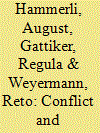

|
|
|
| 10 |
ID:
145698


|
|
|
|
|
| Summary/Abstract |
This article applies recent advances in network analysis to highlight a central tension faced by policymakers – balancing the benefits of engaging with the international system and the associated domestic policy costs. International trade rewards certain domestic practices, such as respect for human rights. Enforcing such practices, however, is politically costly and sometimes prohibitive to state leaders who rely on political repression to stay in power. In such cases, domestic elites often resort to an alternative strategy of securing the benefits of international trade – setting up indirect trade channels through intermediary states. These competing incentives are modeled within a single framework using a formal network game in which states form trade-links (direct or indirect) with other states, while simultaneously choosing their optimal level of domestic human rights protections. The model suggests that there may be an inverse relationship between a state’s embeddedness within a network of indirect trade and respect for human rights: indirect trade channels serve as loopholes that allow domestically troubled states to enjoy the benefits of trade without pressure for domestic improvement. The predictions are supported by the results of the empirical analyses of the international trade and repression data (1987–2000), conducted using a coevolutionary actor-oriented longitudinal-network model – a statistical estimator that closely mimics the theoretical model.
|
|
|
|
|
|
|
|
|
|
|
|
|
|
|
|
| 11 |
ID:
145168


|
|
|
|
|
| Summary/Abstract |
This study examines the unintended consequences of decapitation strategies. Two Islamist terror networks in Spain have been used to critically evaluate theories of leadership removal guided by large-N cross-sectional research. Arguably, current models neglect to include relational variables that constitute the foundation for policies of network disruption. Spanish terror networks are mapped out over a 10-year period (1995–2004) to demonstrate the importance of network variables. Policies meant to disrupt militant networks can generate unintended consequences, as was the case with Spain’s Operation Dátil following the 9/11 attacks on the Twin Towers and the Pentagon in the United States. The Madrid train bombing network developed in the vacant political space following the counterterrorism operation that targeted radical Islamists in Spain.
|
|
|
|
|
|
|
|
|
|
|
|
|
|
|
|
| 12 |
ID:
172339
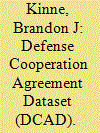

|
|
|
|
|
| Summary/Abstract |
The academic study of defense cooperation focuses heavily on formal military alliances. Yet, governments rarely sign new alliances, and the global alliance structure has remained relatively static for decades. By contrast, governments are increasingly active in defense cooperation agreements (DCAs). These bilateral framework treaties institutionalize their signatories’ day-to-day defense relations, facilitating such wide-ranging activities as defense policy coordination, joint research and development, weapons production and arms trade, joint military exercises, training and exchange programs, peacekeeping, and information exchange. Nearly 2,000 DCAs have been signed since 1980. Preliminary evidence suggests that DCAs impact numerous security, military, and defense outcomes and that governments increasingly incorporate DCAs as core elements of their security strategies. This article introduces the new DCA Dataset (DCAD). I provide a brief historical background on DCAs and compare them to other commonly studied forms of defense cooperation. I then explain coding standards and describe the data set in detail. Finally, I illustrate applications of DCAD to militarized interstate disputes and arms trade.
|
|
|
|
|
|
|
|
|
|
|
|
|
|
|
|
| 13 |
ID:
144083


|
|
|
|
|
| Summary/Abstract |
Suicide attacks continue to plague a multitude of conflict zones. However, the scholarly literature on the phenomenon has yet to produce a theory that explains why militant organizations at different stages of development, facing dissimilar enemies, and situated in unique conflict environments adopt suicide attacks. Moreover, the suicide-attack phenomenon now presents an intriguing puzzle. While most militant organizations fail to achieve their core political ends or ‘outcome goals’, organizations that employ suicide attacks are even less likely to succeed. Still, organizations have adopted suicide attacks at increasing rates. Given their ineffectiveness in precipitating outcome-goal success, why do organizations continue to adopt suicide attacks? Like all organizations, militant organizations share two common aims: (1) to survive and (2) to achieve outcome goals. As martyrdom operations often fulfill the ideological or cultural expectations of certain identity groups, representative organizations may adopt suicide attacks to expand constituent support or enhance status within a particular political landscape. Further, organizations can conduct suicide attacks to signal ideological solidarity with fellow militant organizations. This article analyzes an original large-N dataset of militant organizations alongside an original database of over 5,000 suicide attacks, and evaluates numerous case examples. The results demonstrate that militant organizations across regions and over time have adopted suicide attacks in order to gain supporters, promote organizational longevity, and boost or preserve status.
|
|
|
|
|
|
|
|
|
|
|
|
|
|
|
|
| 14 |
ID:
192056
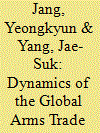

|
|
|
|
|
| Summary/Abstract |
This study identifies security-related factors affecting the formation of the global arms trade network. This empirical analysis using a quantitative approach includes data from multiple sources (the Global Peace Index, Political Stability Index, Democracy Index, Global Terrorism Index, Fragile State Index, and military expenditure as a percentage of GDP) and multiple states analyzed using the ERGM. Arms trade data related to six attributes of states representing their (in)stability is collected and analyzed for 2012-2018. Our findings are as follows: (1) states with greater internal stability import more arms, which affects the formation of the global arms trade network; (2) states with greater external instability import more arms, which also affects the formation of the global arms trade network. This study makes two academic contributions, as follows. First, we analyze factors that form the global arms trade network from a holistic or systemic perspective. Second, we analyze those factors empirically and statistically from a security perspective.
|
|
|
|
|
|
|
|
|
|
|
|
|
|
|
|
| 15 |
ID:
160863
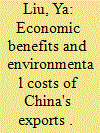

|
|
|
|
|
| Summary/Abstract |
This paper decomposes economic benefits (value‐added) and environmental costs (CO2) of exports according to their sources, and maps the global value network (GVN) and the global emissions network (GEN) for China's exports during 1995–2009 from national, sectoral and national–sectoral perspectives. A comparison is conducted between China and the USA. National GVN and GEN show that shares of value‐added and CO2 emissions from China in its GVN and GEN both decreased first then increased after 2006, while shares from the USA in its GVN and GEN generally decreased. Sectoral GVN and GEN show that among China's exports, “electrical and optical equipment” and “electricity, gas and water supply” were, respectively, the sectors that obtained the most value‐added and emitted the most CO2. National–sectoral GVN and GEN for China exhibited reciprocal and disassortative patterns, and in‐strengths and out‐strengths of GVN and GEN for China's exports were mainly captured by several domestic country–sector pairs.
|
|
|
|
|
|
|
|
|
|
|
|
|
|
|
|
| 16 |
ID:
190217


|
|
|
|
|
| Summary/Abstract |
While many have observed a regime complex for global clean energy governance, research has not yet accorded sufficient attention to the interplay of multiple streams of politics that have led to the structuring of overlapping governance initiatives and, ultimately, the articulation of a set of norms that hold this regime complex together. To understand these dynamics, this article argues that with the visibly increased agency of transnational actors and international organizations, four mechanisms together are likely to shape regime complexity: divergent state preferences, the agency of transnational actors, practices of intergovernmental organizations, and interorganizational recognition and normative legitimation. Drawing on a qualitative analysis of policy documents and interviews, and a social network analysis, it studies global clean energy governance from 1980 to 2014 to illuminate these dynamics. The findings suggest that the combination of these four mechanisms can explain the evolution from a nonregime to a loosely coupled governance system for clean energy.
|
|
|
|
|
|
|
|
|
|
|
|
|
|
|
|
| 17 |
ID:
191916


|
|
|
|
|
| Summary/Abstract |
How do states distribute the burdens of collective defense? This paper develops a network theory of burden sharing. We focus on bilateral defense cooperation agreements (DCAs), which promote cooperation in a variety of defense, military, and security issue areas. Using a computational model, we show that DCA partners’ defense spending depends on the network structure of their agreements. In bilateral terms, DCAs increase defense spending by committing states to defense activities and allowing partners to reciprocally punish free riding. However, as a state's local network of defense partnerships grows more densely connected, with many transitive “friend of a friend” relations, DCAs have the countervailing effect of reducing defense spending. The more deeply integrated states are in bilateral defense networks, the less they spend on defense. We distinguish two potential mechanisms behind this effect—one based on efficiency improvements, the other on free riding. An empirical analysis using multilevel inferential network models points more to efficiency than to free riding. Defense networks reduce defense spending, and they do so by allowing countries to produce security more efficiently.
|
|
|
|
|
|
|
|
|
|
|
|
|
|
|
|
| 18 |
ID:
101688


|
|
|
|
|
| Publication |
2010.
|
| Summary/Abstract |
In this article, it is argued that interstate alliances function as public costly signals of state intentions to cooperate militarily, and as such, they should be expected to influence state expectations within dyads, between dyads, and across time. Accurate statistical modeling of interstate military alliances thus requires that researchers escape the assumption of independent units of observation, which is built into most of the statistical tools currently used by international relations scholars, as such models can be expected to produce unbiased parameter estimates in this domain only if the decisions to create and dissolve interstate alliances are formulated in isolated dyadic bubbles. The use of stochastic actor-oriented models, combined with Markov simulations of network evolution, is shown to be a productive alternative method of modeling interstate alliances, which allows the researcher to avoid the assumption of dyadic independence by incorporating theory-driven assumptions about patterns of extra-dyadic interdependence directly into the functional form of the statistical model. The results demonstrate that triadic patterns of amity and enmity exercise powerful influence over the selection of alliance partners and the evolution of the global alliance network. The results also show that failure to incorporate patterns of extra-dyadic interdependence into our statistical models of interstate alliance decisions is likely to result in biased parameter estimates.
|
|
|
|
|
|
|
|
|
|
|
|
|
|
|
|
| 19 |
ID:
115204


|
|
|
|
|
| Publication |
2012.
|
| Summary/Abstract |
Bilateral trade agreements have proliferated rapidly within the last two decades, growing into a dense network of multiple ties between countries. The spread of preferential trade agreements (PTAs), however, is not uniform: some countries have signed a multitude of deals, while others remain much less involved. This article presents a longitudinal network analysis method to analyze the patterns of the formation of trade agreements, based on the mutual codetermination of network structure and agreement formation. The findings suggest that PTAs spread endogenously because of structural arbitrage effects in the network, and that they establish a hierarchy among countries. Rich countries form ties with each other and middle-income countries, who themselves create a horizontal layer of PTAs, but least-developed countries are left behind and do not form many ties. Supplanting the multilateral trade regime with preferential agreements therefore creates a system of highly asymmetrical relationships of weaker spokes around a few hubs.
|
|
|
|
|
|
|
|
|
|
|
|
|
|
|
|
| 20 |
ID:
124976


|
|
|
|
|
| Publication |
2013.
|
| Summary/Abstract |
Existing studies of intergovernmental organizations (IGOs) and militarized conflict focus on dyadic counts of shared IGO membership. However, dyadic approaches are inconsistent with the basic properties of IGOs. Because IGOs are multilateral organizations, shared membership necessarily involves ties to third parties. This article employs network analytics to develop a novel explanation of how third-party IGO ties reduce militarized conflict. The analysis first examines the 'structural similarity' of states, defined by the extent to which states share similar patterns of IGO membership with relevant third parties. High levels of structural similarity indicate that states interact with a common set of IGO collaborators. The analysis then shows that micro-level changes in IGO membership effect changes in structural similarity, leading to the macro-level phenomenon of 'network convergence,' wherein states increasingly collaborate with the same third parties over time. Substantively, convergence results in increased overlap and integration between states' respective local networks of IGO partners. Because network convergence is costly, involving a combination of IGO-based accession, sovereignty, and alignment costs, it is unlikely to be pursued by purely exploitative state types. Consequently, convergence provides cooperative types with a mechanism for signaling a preference for cooperation over conflict. These credible signals in turn establish mutual trust among cooperators and effectively reduce the risk of militarized conflict. Extensive empirical analysis shows that, in fact, network convergence strongly correlates with a decline in militarized dispute initiations. The more that states collaborate with one another's IGO partners, the less likely they are to fight.
|
|
|
|
|
|
|
|
|
|
|
|
|
|
|
|
|
|
|
|
|